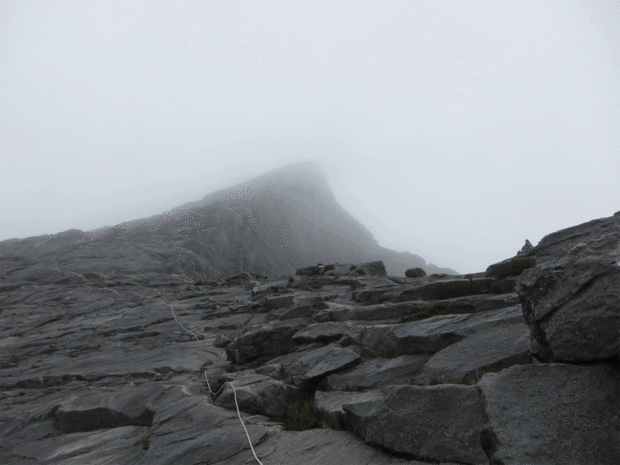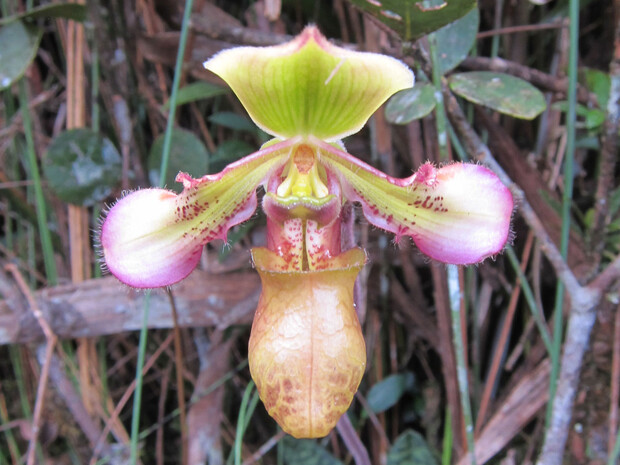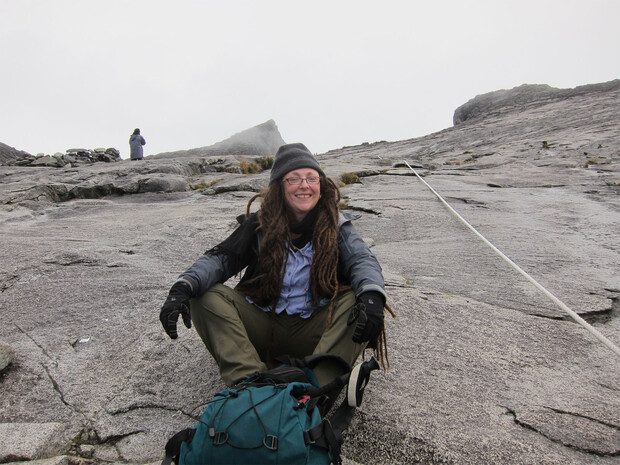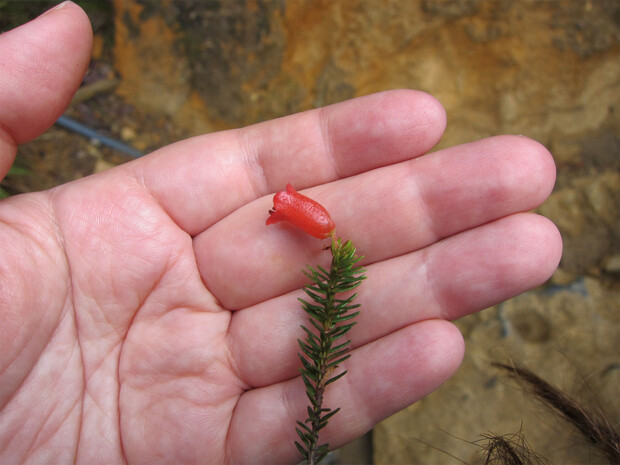Borneo’s Mount Kinabalu stands as a geologic monument to plant diversity, laying claim to thousands of species — including the world’s largest flower, a grapevine-sapping parasite that grows 3-plus feet wide and draws pollinating flies with a stench of decay.
But on certain slopes of the 13,435-foot mountain, that botanical cradle becomes a crucible, testing the adaptability and resilience of flora in a way that few other places on the planet can. Covering about 5% of those slopes is ultramafic soil: nutrient-poor, water-deprived and rich in heavy metals — chromium, iron, nickel — that are toxic to most, but not quite all, plants. It’s the sort of unique environment that spawns carnivorous pitcher plant species and other fantastical species found only on the equator-straddling island of Southeast Asia.
According to a recent study led by the University of Nebraska–Lincoln’s Melissa Whitman and Sabrina Russo, that hardscrabble, hard-won existence might also grant the ultramafic species an elevational versatility and stress tolerance that could prove favorable amid ongoing climate change.
“Many of these ultramafic species are just some of the most fabulous plants,” said Whitman, a doctoral alumna of Nebraska who conducted the research for her dissertation.
Whitman’s early fascination with the plants only deepened after diving into a series of thick monographs that contain more than a century’s worth of taxonomic records on the multitudinous species native to Mount Kinabalu.
“I began to randomly flip open to a page, look at a species, read the description, and think about it,” she said. “And I began noticing that the ultramafic species tended to have differences in the descriptions of where they’re found, forming distinct communities.”

Left: A photo of Rhododendron javanicum taken at more than 6,800 feet above sea level. Right: A species of tropical pitcher plant growing on a defunct mining site. Courtesy photo
Intrigued, she reached out to Reed Beaman, son of the monographs’ late author, John, who had dedicated decades to the painstaking task of cataloging Mount Kinabalu’s botanical bounty. Later, Whitman would attend an academic conference in Borneo itself, where she met other researchers who have likewise made Mount Kinabalu their life’s work.
While there, Whitman joined some of her fellow ecologists in scaling the mountain, overlaying the copious knowledge she had gleaned from the monographs with the sight, smell and touch of experience. At the base, the ecologists were greeted by the towering trees and ropelike vines of tropical rainforest. Further up, they entered an envelope of constant fog, encountering mosses and ferns and an assortment of orchid species. Beyond that, a marked drop in the height of the canopy, with trees shrinking and shrubs emerging, then predominating. Finally, above the clouds, a summit of exposed granite — what Whitman called “a very bizarre place” that can alternate between mist-blanketed sogginess and freezing, desert-like dryness.

“It’s just very interesting to experience these transitions in the landscape and then take notes of what species occur where,” Whitman said. “Some of the ideas that went into this paper came just from walking slowly and thinking, ‘OK, I observe this while hiking, but how much of this is actually expressed via the numbers?’”
Some of those numbers would come to define her study: 3,060 plant species from 193 families, accompanied by the minimum and maximum elevations at which they were found. Also, crucially, 1, 2 and 3 — a 1 for species seen exclusively or mostly in ultramafic soils, a 2 for species occasionally spotted in them, a 3 for species never known to set down roots in them.
Given Mount Kinabalu’s unusually high proportion of the harsh soils, the researchers saw it as an ideal place to analyze how the earth itself might be regulating the ranges of the plants sprouting from it.
“It seems hard to believe, but the idea that soil fertility is important in determining species distributions at multiple spatial scales is only recently gaining more emphasis in ecology,” said Russo, professor of biological sciences and Whitman’s doctoral adviser at Nebraska.
“That’s something I found very much absent from a lot of the macroecological research literature,” Whitman said. “It was this entire focus on climate, but almost nothing about the soil. And that’s a huge factor.”

The mountain also provided a test case for Rapoport’s rule, which rose to prominence in the early 1990s and has been a subject of debate among ecologists ever since. The rule proposes that the range sizes of organisms generally increase alongside latitude — away from the equator, toward the poles — and altitude, so that species enjoy larger ranges at higher elevations.
Whitman and Russo wanted to know not just if the elevation-based trend held for plant species on the iconic Mount Kinabalu, but also whether deviations or caveats might emerge when comparing the ultramafic vs. non-ultramafic species.
“In other parts of the globe where you have ultramafic soil, it tends to be within a limited elevation range,” Whitman said, noting that Kinabalu’s patches of the ultramafic instead stretch from its base to about 10,000 feet above sea level. “So this is a unique opportunity where you can tease apart: Is it the elevation that’s causing these differences in range size, or is it the soil?”
The verdict? Across all 3,060 species, the average range size did increase with elevation, as Rapoport’s rule would predict. When splitting the analysis by the species’ favored soil type, though, a more nuanced, interesting picture snapped into focus.
The team discovered, to Whitman’s surprise, that the ultramafic species — a group of specialists if ever there was one — generally boast larger range sizes than would be expected at a given elevation. Those ranges are consequently more likely to overlap, meaning that many stretches of the mountain feature a richer variety of ultramafic species than expected. In contrast, the ranges of non-ultramafic species tend to be smaller than anticipated, despite accounting for 62% of the plant species on the mountain.
Whitman and Russo said the findings suggest that, in evolving tolerance to the severe resource limitations imposed by take-no-prisoners soil, ultramafic species may also better contend with similar stressors thrown at them by high altitudes, climate and other factors. That spillover resilience may have widened the breadth of ecological niches they can successfully adapt to, enabling them to expand their geographic ranges in the process. Even former mining sites are not off-limits to them, as Whitman witnessed during her summit of the mountain.

But with that climb having exposed her to the jarring differences among the verdant, tropical ecosystem of the mountain’s base, the temperate cloud forests of its mid-elevations, and the alpine scrublands near its peak, Whitman suspected that ecosystem boundaries were shaping distributions, too. So she also developed several models to gauge the potential influence of the so-called vegetation zones.
“The geographic distance isn’t that far,” Whitman said, “but the difference in climate is relatively huge for these plants.”
Sure enough, she found that species distributions were best explained by a model that incorporated both soil type and the boundaries between vegetation zones, marking each as a critical factor in determining those elevational distributions. The model also indicated that those boundaries occur at higher elevations for the ultramafic than the non-ultramafic species.
“Prior research on vegetation zone boundaries was often based off patterns observed for the majority of species, and ultramafic species are a distinct minority,” Whitman said. “So that’s probably why that detail was missed.”

One lingering question: whether the ultramafic species’ tolerance of extremes, soil and otherwise, can help them contend with one of the most abrupt shifts in climate the planet has ever seen. As temperatures continue rising in response to the accumulation of greenhouse gases in the atmosphere, a species’ preferred climate conditions may shift up to higher altitudes, the researchers said, whether on Mount Kinabalu or other peaks.
Species with wider elevational ranges and more inherent tolerance to heat or water stress may find it more feasible to weather changes in their own microclimates, the researchers said. That would seem to position ultramafic species as winners, or at least survivors, of a future that could look very different than the present. As Whitman and Russo were quick to point out, though, only time will tell — especially if the poor-soil specialists find themselves in more direct competition for resources with their non-ultramafic counterparts.
“You could say that ultramafic plants don’t have to worry about climate change, because they’re already adapted to stress,” Whitman said. “But in actuality, they may have to worry about it, in that you could see distributional shifts in other plant species that may affect the competitive landscape.”
The researchers detailed their findings in the journal Ecography. Whitman and Russo authored the study with Beaman; Kanehiro Kitayama of Kyoto University; Rimi Repin of Sabah Parks, a conservation-focused body that oversees Kinabalu Park; and Shin-Ichiro Aiba of Hokkaido University.
The team received support from the National Science Foundation’s Graduate Research Fellowship Program and Nebraska’s School of Biological Sciences.





